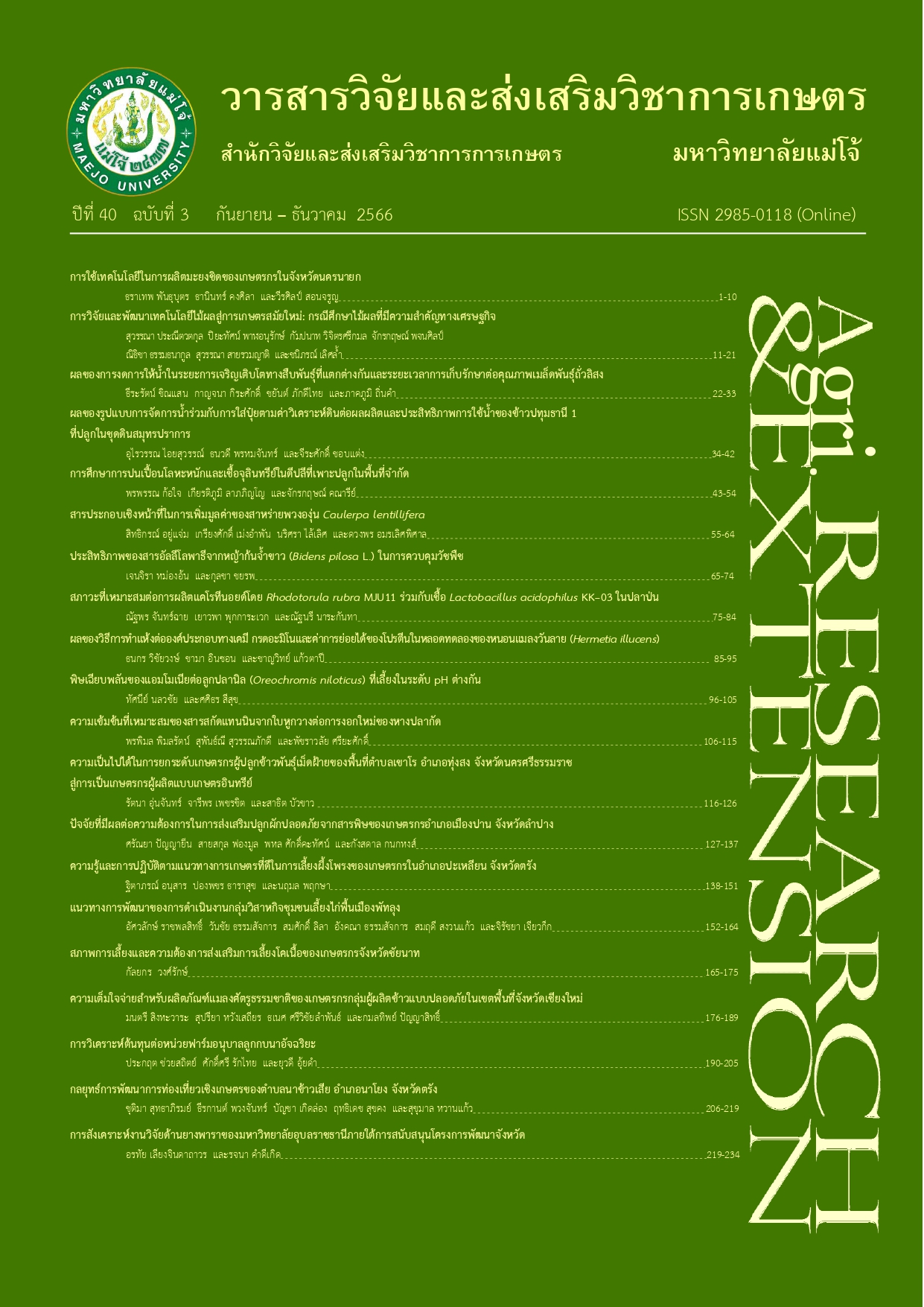พิษเฉียบพลันของแอมโมเนียต่อลูกปลานิล (Oreochromis niloticus) ที่เลี้ยงในระดับ pH ต่างกัน
คำสำคัญ:
พิษเฉียบพลัน, แอมโมเนีย, pH, ลูกปลานิลบทคัดย่อ
การศึกษาพิษเฉียบพลันของแอมโมเนียต่อลูกปลานิล (Oreochromis niloticus) ที่เลี้ยงในระดับ pH 5, 7 และ 9 โดยใช้วิธีชีววิเคราะห์แบบน้ำนิ่ง (Static bioassay) เพื่อหาระดับความเข้มข้นของแอมโมเนียที่ทำให้ลูกปลานิลตายครึ่งหนึ่ง (Median lethal concentration) ภายในระยะเวลา 24 ชั่วโมง (24-hr LC50) ทำการทดลองโดยนำลูกปลานิลขนาดความยาวเฉลี่ย 3 ซม. ใส่ในโหลทดลองขนาดความจุ 2.5 ลิตร (10 ตัว/โหล) บรรจุน้ำ 2 ลิตร ที่มี pH 3 ระดับ ได้แก่ pH 5, 7 และ 9 สังเกตพฤติกรรมและอัตราการตายของลูกปลานิลภายในระยะเวลา 24 ชั่วโมงคำนวณหาค่าความเข้มข้นที่ทำให้ลูกปลานิลตายครึ่งหนึ่งด้วยการวิเคราะห์โปรบิท (Probit analysis) พบว่า ที่ระดับ pH 5, 7 และ 9 มีค่า 24-hr LC50 ของแอมโมเนียเท่ากับ 2.35 (1.07-5.21), 10.54 (6.34-18.76 และ 1.56 (0.72-3.43) ppm ตามลำดับ ผลจากการศึกษาครั้งนี้แสดงให้เห็นว่าระดับ pH ที่แตกต่างกันมีผลต่อความเป็นพิษของแอมโมเนียและอัตราการตายของลูกปลานิล โดยระดับ pH 9 จะทำให้แอมโมเนีย มีความเป็นพิษต่อลูกปลานิลมากที่สุด รองลงมาคือ ระดับ pH 5 และ 7 ตามลำดับ
เอกสารอ้างอิง
American Public Health Association (APHA). 1992. Standard Method for the Examination of Water and Wastwater. 18th. Washington, D.C: American Public Health Association. 1360 p.
Asawaketmanee, N. 2006. Freshwater Fish Culture. Songkhla: Faculty of Agricultural Technology, Songkhla Rajabhat University. 168 p. [in Thai]
Boyd, C.E. 1982. Water Quality Management for Pond Fish Culture. New York: Elsevier Scientific Publishing Company. 318 p.
Boyd, C.E. and C.S. Tucker. 1998. Pond Aquaculture Water Quality Management. Boston: Kluwer Academic Publishers. 700 p.
Chansue N. 2010. Fish Disease: Internal Medicine and Clinical Practice. Bangkok: Holistic Publishing. 691 p. [in Thai]
Chen, J.C. and S.Y. Cheng. 1993. Studies on hemocyanin and haemolymph protein levels of Penaeus japonicus based on sex, size and moulting cycle. Comp. Biochem. Physiol. 106: 293-296.
Chervinski, J. 1982. Environmental Physiology of Tilapia. pp. 119-128. In Pullin, R.S.V. and R.H. Lowe-McConnell. (eds.). The Biology and Culture of Tilapia. In ICLARM Conference Proceedings 7. Manila: International Center for Living Aquatic Resources Management.
Dent, D. 1986. Acid Sulphate Soils: A Baseline for Research and Development. Netherlands: International Institute for Land Reclamation and Improvement. 204 p.
Finney, D.J. 1971. Probit Analysis. 3rd edition. Cambridge: Cambridge University. 331 p.
Hiranwattana, S., B. Sricharoentham and R. Pitipornchai. 1993. Tilapia Cage Culture in Dokgrai Reservoir, Rayong Province. 33 p. In Research Report. Bangkok: Inland Fisheries Research Institute, Department of Fisheries. [in Thai]
Kaewmanee, C. 2009. Substitution of Fish Meal with Plant Protein in Diets on Nursing of Tilapia (Oreochromis spp.) Growth Performance, Ammonia Excretion and Disease Resistance after Transportation. Master Thesis. Kasetsart University. 207 p. [in Thai]
Keratethaweesuk A., O. Jintasataporn and Y. Musig. 2013. Acute Toxicity of Metaldehyde and Acute Toxicity of Ammonia Plus Metaldehyde in Nile Tilapia (Oreochromis niloticus). pp. 449-456. In Proceedings of 51st Kasetsart University Annual Conference, 5-7 February 2013. Bangkok: Kasetsart University. [in Thai]
Kongprasert, C. 2000. Fish Farming. 1st. Bangkok: Kasetsart Book Publishing. 223 p. [in Thai]
Laongsiriwong, N., K. Silpachan and L. Laongsiriwong. 2000. Ammonia and Aquaculture. 8 p. In Research Report. Songkhla: Coastal Aquaculture Research and Development Division. [in Thai]
Limsuwan C. 2000. Thai Shrimp 2000. Bangkok: Charanrat Printing House. 260 p. [in Thai]
Mac Intyre, C.M., T. Ellis, B.P. North and J.F. Turnbull. 2008. The Influences of Water Quality on the Welfare of Farmed Rainbow Trout: A Review; In Fish Welfare. Singapore: Blackwell Publishing Ltd. 299 p.
Nonwachai T. 2012. Effects of Dissolved Oxygen, Ammonia and pH Levels on Feed Intake, Growth, Survival, Non- Specific Immune Characteristic of Pacific White Shrimp (Litopenaeus vannamei) and Challenged with Vibrio harveyi. Doctoral Dissertation. Kasetsart University. 129 p. [in Thai]
Nonwachai T. and S. Wanjing. 2016. Effect of pH levels and ammonia on survival rate of red hybrid tilapia larvae (Oreochromis sp.). Khon Kaen Agriculture Journal 44(1): 644-645. [in Thai]
Prasertsom S. 2004. Acute Toxicity of Ammonia on Sea Bass Fry (Lates calcarifer, Bloch). 19 p. In Research Report. Songkhla: Coastal Aquaculture Research and Development Division. [in Thai]
Robert, V.T., R.C. Russo and C.E. Smith. 1978. Acute toxicity of ammonia and nitrite to cutthroat trout fry. Trans. Am. Fish. Soc. 107(2): 361-368.
Thongdon-A.R. 2013. Study on Diseases and Parasites in Cage-cultured Red Hybrid Tilapia (Oreochromis sp.). Doctoral Dissertation. Kasetsart University. 178 p. [in Thai]
Throp, F.J. and P.S. Lake. 1974. Toxicity bioassays of cadmium and zinc on the freshwater shrimp, Paratya tasmanensis. Marine and Freshwater Research 25: 97-104.
Wajsbrot, N., A. Gasith, M.D. Krom and D.M. Popper. 1991. Acute toxicity of ammonia to juvenile gilthead seabream Sparus aurata under reduced oxygen levels. Aquaculture. 164: 227-288.
ดาวน์โหลด
เผยแพร่แล้ว
รูปแบบการอ้างอิง
ฉบับ
ประเภทบทความ
สัญญาอนุญาต
ลิขสิทธิ์ (c) 2023 วารสารวิจัยและส่งเสริมวิชาการเกษตร

อนุญาตภายใต้เงื่อนไข Creative Commons Attribution-NonCommercial-NoDerivatives 4.0 International License.
บทความนี้ได้รับการเผยแพร่ภายใต้สัญญาอนุญาต Creative Commons Attribution-NonCommercial-NoDerivatives 4.0 International (CC BY-NC-ND 4.0) ซึ่งอนุญาตให้ผู้อื่นสามารถแชร์บทความได้โดยให้เครดิตผู้เขียนและห้ามนำไปใช้เพื่อการค้าหรือดัดแปลง หากต้องการใช้งานซ้ำในลักษณะอื่น ๆ หรือการเผยแพร่ซ้ำ จำเป็นต้องได้รับอนุญาตจากวารสาร





